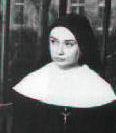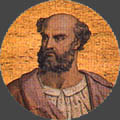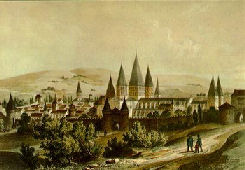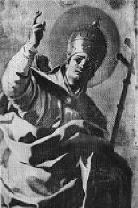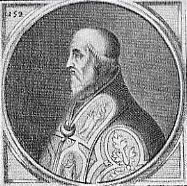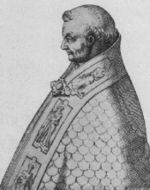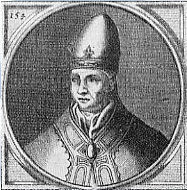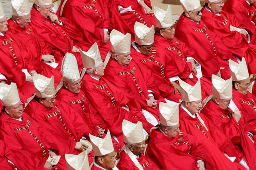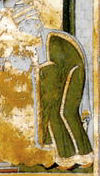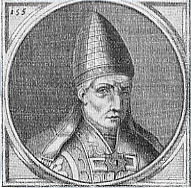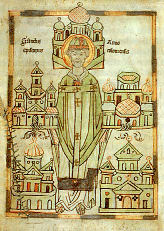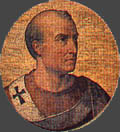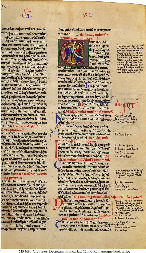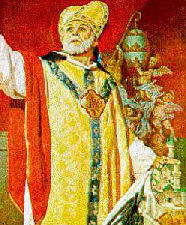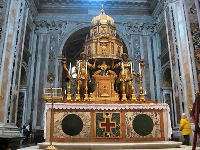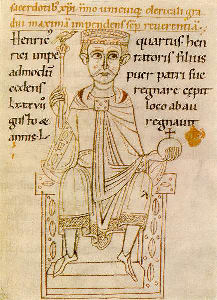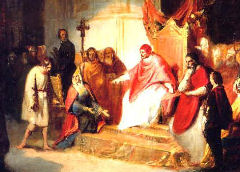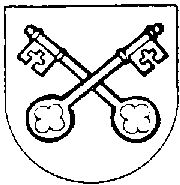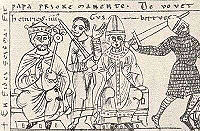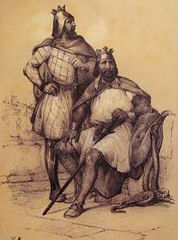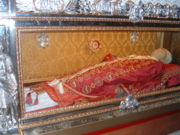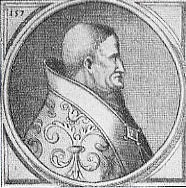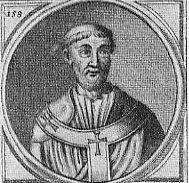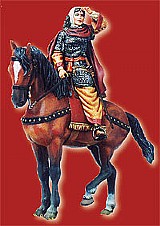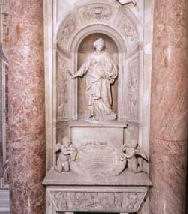Chapter 7: Hildebrand Recognition
The Post-Pornocracy Papacy
Many shameful epithets may be appropriate for Pope Benedict IX's pontificate, but nobody has ever called it boring. The string of empire-friendly[1] foreigners who followed the young Tusculan, however, left a lot to be desired in the department of cool. To make matters worse, a diminutive figure huddled restively on the bench, and anyone with half an eye could see that he could outpope any of them. First came the ill-starred Bavarian Poppo, hand-picked by the emperor and forcibly installed as Pope Damasus II by Boniface, the Margrave of Tuscany, in July of 1048. Shortly thereafter Damasus sought refuge from the stifling Roman heat in Palestrina, where he died after a pontificate of only twenty-three days. Many suspected that the deposed Pope Benedict, still in the prime of life, had poisoned his successor. Benedict may have been capable of it, but it is equally likely that the new pontiff succumbed to malaria or some other ailment.The astonishing young Tuscan named Hildebrand became involved in Church politics at about this time. He was a monk, but the conventional image of the world-weary laborer in the fields of the Lord or the cloistered scribe meticulously illuminating dusty manuscripts do not do him justice. Appearances are sometimes deceptive. Stephens described him as “a young man of small stature and ungainly figure, feeble in voice, dull in complexion, but with a bright piercing eye.”[2] De Rosa called him a dwarf. Alone among the prominent figures of ecclesiastic history, he dominated the policies of the Church before, during, and even after his pontificate. Nevertheless, Sr. Mary Immaculata never mentioned him, at least not that I recall.[3]
A council at Worms elected the next pope in 1049. Even S’ter might have trouble justifying a council of Germans selecting Rome’s bishop, but no one dared challenge their choice of Bruno, who was Bishop of Toul and a noble of the house of Alsace and Lorraine. On his way to Rome Bruno stopped at the influential abbey at Cluny and met with its prior, Hildebrand.[4] The pope-elect learned that he should seek approval from the Romans before accepting the nomination. Hildebrand appreciated the Romans’ antipathy toward outsiders who had been forced on them, and it was much worse when the orders came from Germany. He gave the pope-elect extremely good advice. After the Romans voted him in, Bruno triumphantly ascended St. Peter’s throne as Pope Leo IX. Aside from his bitter conflicts with the Greek Church, Pope Leo is best remembered for reducing the rampant simony and licentiousness in the clergy. He sponsored a number of councils that excommunicated some of the worst offenders and established standards for the future. He never felt, however, that he could defrock all priests who had engaged in simony, sex, and worse. He admitted in a letter to St. Peter Damien that “the number of guilty clerics rendered that proceeding impossible, and obliged him to preserve even the criminal in the church.”[5] Leo spent little time in Rome; he seemed more comfortable in Emperor Henry III’s company. In 1053 Leo returned to Italy at the head of an army, but he was defeated by the Normans and was held as a prisoner in Benevento. From his cell he dispatched Bishop Humbert on the disastrous mission to Constantinople. The next year his Norman captors acceded to the wishes of the very sickly pontiff and transported him to Rome so that he could die in St. Peter’s. The papacy was then vacant for a year because the Romans, not wishing to provide the emperor with the slightest provocation for an invasion, forbore holding an election. They finally settled on Gebehard, the emperor’s relative and counselor, and dispatched Hildebrand to Germany to ascertain the emperor’s opinion. Hildebrand first persuaded the bishops of Germany to vote for Gebehard; the bishops in turn lobbied for Henry’s endorsement. The emperor eventually gave in to Hildebrand’s persistence and persuasiveness. Gebehard became Pope Victor II. Not much memorable resulted from his two-year stint. He employed Hildebrand as his legate to France while he remained close to the emperor. In fact, Henry reportedly died in his arms. The pope himself expired before he could return to Rome. The last pope to select the name Stephen was another rich noble. His given name was Frederick, and his brother was Godfrey, the Duke of Lorraine who during Leo IX’s pontificate had negotiated an alliance with the emperor. Frederick managed to get himself elected pontiff in 1057. His eight-month pontificate came down hard on monks and priests who used their offices to for self-aggrandizement. In 1058 Gérard de Bourgogne, the Bishop of Florence, became pope with the name Nicholas II. He was unpopular with the Roman nobles, who supported an antipope named Benedict X. Hildebrand, however, cleverly endorsed Nicholas. Benedict was expelled from Rome by forces loyal to the empire and the aforementioned Godfrey, who by then had married Beatrice, the Countess of Tuscany. Pope Nicholas’s greatest claim to fame is that he brought Hildebrand back to Rome and elevated him to the rank of cardinal and archdeacon.By 1059 Hildebrand’s power in Rome was, according to The Catholic Encyclopedia, “supreme.”[6] He worked with Pope Nicholas to craft a set of reforms aimed at insulating the papacy from the influences of both Roman civilians and German nobility. The task would not be easy; these reforms upset many clerics, Roman laymen, and nearly all nobles. Pope Nicholas only survived for two and a half years, too little time to address more than a few items on the agenda.
Dueling Pontificates
The papal election of 1061 marked the debut of the convention of cardinals that eventually became the conclave.[7] Nicholas had decreed in 1059 that the selection of future popes would require a unanimous vote of the College of Cardinals. The familiar international flavor of the college was then totally absent; only eleven cardinals from dioceses near Rome participated in the first election. No say at all in the selection of the pope was accorded to the laity, and the emperor’s veto privilege had tacitly been eliminated. Nicholas’s decree specified only that “due regard” should be given to the emperor’s wishes. Strictly speaking, there was no emperor when Pope Nicholas died in 1061, since Henry III had been deceased for five years. His eleven-year-old son Henry IV was acknowledged as King of Germany. The youngster’s mother, Empress Agnes, served as his regent. Shepherded by Cardinal Hildebrand, the cardinals quickly chose his cohort Anselmo da Baggio, the Bishop of Lucca, as Pope Alexander II. The Roman nobility was outraged at its exclusion and immediately petitioned the German court to intervene. Empress Agnes convened a council at Basel. The bishops in attendance elected as pope the Bishop of Parma, Cadalus, with the name Honorius II. Whether he intended to pay homage to the heretical pope or to the emperor who cared more about his poultry than Alaric’s sacking of Rome is anybody’s guess. In 1062 German troops descended into Italy. A bloody battle gave Honorius control of most of Rome, including St. Peter’s. However, disastrous news from Germany soon arrived. Archbishop Anno of Cologne had overthrown Agnes and become Henry’s regent. Honorius withdrew to Parma during negotiations with the new regent. Worried that his pontificate would not be upheld, he returned to Rome and seized Castel Sant’Angelo. About a year later and one excommunication wiser, he returned to Parma, where he died in 1072. Although he never abdicated, he is considered an antipope. Whenever he could elbow his way into Rome, Pope Alexander sponsored reforms until his death in 1073. As Hildebrand finally assumes center stage, it seems appropriate to consider his background and how he came to be such a monomaniacal force. Unfortunately, the many biographers of this critical figure in Church history disagree on a number of basic details. He probably was born in Sovana, a town in southern Tuscany, some time between 1013 and 1025. The most commonly cited date is 1020. His father may have been a carpenter; little is known about his mother. As a youth he was packed off to Rome, where he came under the tutelage of his uncle, the abbot of a monastery. He became a monk, but not a priest. He evidently developed a close association with Pope Gregory VI, the man who purchased the papacy from his godson, Benedict IX. When Gregory was exiled by Emperor Henry III in 1046, Hildebrand followed him into Germany. When the deposed pontiff died a little over a year later, Hildebrand went to the monastery at Cluny. Accounts differ as to how much time he spent there before he was summoned to Rome by Pope Nicholas II.Nearly everyone praises Hildebrand’s intelligence and competence. He was obviously very persuasive in oratory and conversation. He certainly was fanatically devoted to restoring the power of the papacy and to reforming the entire Church. How he came by these attitudes and aptitudes remains open to conjecture.
The cardinals in Rome did not even wait for Pope Alexander’s funeral to end before they acclaimed Hildebrand as the new pontiff; he was unanimously elected as Pope Gregory VII.[8] He immediately notified the emperor and waited for imperial recognition of his election before authorizing the consecration ceremony. By then Henry IV had reached the age of twenty-three and did not have to ask his mommy, the archbishop, or anyone else for permission. He probably based his decision to confirm Hildebrand’s nomination on the monk’s reputation as a reformer. This amicable beginning soon devolved into the most dramatic confrontation between Church and state in European history.
In short order Pope Gregory began reforming the Church, which was by any reckoning still in a miserable state. He resolved to eliminate simony, enforce celibacy among the clergy, and establish the unquestioned authority of Rome, and not just in religious matters. He repeatedly used the Donation of Constantine and other Pseudo-Isidore Decretals to press the Church’s legal claims for land as far afield as Spain. He assembled a cadre of clerics and scholars to amass the evidence to support him in these endeavors. The result was Gratian’s Decretum, a remarkable collection of laws and treatises. In the words of Döllinger and Huber, “All these fabrications – the rich harvest of three centuries – Gratian inserted in good faith in his collection, but he also added, knowingly and deliberately, a number of fresh corruptions, all in the spirit and interest of the Papal system.”[9] From Pope Gregory’s perspective every ruler including the emperor held power only at the pope’s sufferance. He even claimed that every nation, not just England, owed Rome the Peter’s Pence.For the ruling class the most dreaded reform was the elimination of investiture, the traditional right of civilian authorities to appoint local bishops, abbots, etc. When a bishopric fell vacant, the income from the Church properties – as much as 50 percent of the land in some areas – reverted to the king or prince, who would sometimes maximize his take by delaying appointments. Moreover, rulers often appointed friends or relatives or even auctioned bishoprics off. Gregory inveighed tirelessly against these abusive practices, and he curtailed them somewhat. These efforts endeared him neither to the emperor nor the nobility.
The Ravening Wolf
The main effect of excommunications issued by previous popes was to prohibit the named excommunicant from receiving the sacraments until he/she recanted. For believers this was a dire punishment; the sacraments were the ceremonies instituted by Christ by which the faithful gained eternal salvation. Over the centuries the concept of excommunication had been extended to embrace a more practical notion; Christians were barred from social or economic interaction with any excommunicant. This transformed a powerful spiritual tool into a lethal weapon. Shunned persons were hard-pressed to earn an honest living in a Christian community. Their choices were basically repentance or exile. Prior to Pope Gregory's time the X-bomb had been deployed rather sparingly on egregious heretics. Pope Gregory morphed it into a WMD (almost) capable of bringing down the most powerful man in western Europe. Emperor Henry IV was twenty-five years old when a synod under Gregory’s influence forbade kings and laymen from influencing the appointment of bishops. At the synod Gregory excommunicated five of Henry’s advisers for practicing simony. Initially, Henry dutifully complied with the ruling and dismissed the counselors, but later he recalled them and reinstated the practice. Pope Gregory sent a letter encouraging the young sovereign to repent and threatening excommunication if he refused. The pope also dispatched a legation to underscore his intention to follow through on his threat. Back in Rome, Pope Gregory celebrated midnight Mass in the church of St. Mary Major on Christmas of 1075. Cencius Frangipane, a Roman noble and cousin of the imperial prefect, sent his henchmen to disrupt the service. They apprehended Pope Gregory, roughed him up, and imprisoned him. The indignant Roman people rallied and demanded the pope’s release. Cencius liberated Pope Gregory and then fled for his life. You don’t need a weatherman to know which way the wind blows.In January of 1076 Emperor Henry called his own council of bishops and abbots at Worms. The council voted to depose Gregory “as guilty of murder, simony, necromancy, and devil-worship, of habitual, though concealed profligacy, and of impious profanation of the eucharist.”[10] The council even claimed that the Church of Rome was ruled by a senate of three women, one of whom was the emperor’s own mother. Only two of the attending bishops had the fortitude to object to these manifestly preposterous charges.
Henry knew well that all three Ottos and his own father had deposed and appointed popes at will. He likely was taught that every emperor since Charlemagne possessed by God’s will the right of papal investiture. Henry addressed to Hildebrand, as he referred to the pope, a letter that branded him as a “false monk” and ordered him to step down so that a new pope could preach the “sound doctrine of St. Peter.” He also sent a priest named Roland to a synod in Rome to announce “I will tell you, brethren, that you must appear at Pentecost before the king (referring to Emperor Henry) to receive from his hands a pope and father; for this man here is not pope, but a ravening wolf.”These words grated on the bishops, most of whom ardently supported Pope Gregory and his policies. The Holy Father had to restrain them from dispatching Father Roland to the Pearly Gates, where he could solicit St. Peter’s views on “sound doctrine” first hand. Instead, the pope calmly read aloud the text of Roland’s message. Then he excommunicated and deposed Henry in St. Peter’s name and proclaimed that inhabitants of the empire were no longer bound to obey him. Finally, using the language of Matthew, he bound Henry in the bands of anathema, effectively damning him to hell. The pontiff then excommunicated all bishops who had voted at Worms to depose him.
Another emperor might have settled the matter by marching his army across the Alps. Henry’s approach was more subtle; he tried to rally the clergy and nobles of Germany to his cause, but over time he met with less and less success. Some clumsy diplomacy and the weakness he showed on the battlefield cost him the support of one noble after another. Meanwhile, Pope Gregory had formed alliances with the powerful Normans, Robert Guiscard and Count Roger. If they supported him against the emperor, the papal forces on their home turf might rout the imperial troops. After having been shut in with his wife[11] for months, the emperor decided to submit to the pope.
December of 1071 brought extremely frigid weather. Henry nevertheless set forth with his wife and infant son to cross the Alps to seek the pope’s absolution. He arrived at Gregory’s quarters in Canossa,[12] a fortress near Parma in the foothills of the Apennines, on January 21, 1077. De Rosa painted the scene:
Henry, teeth chattering, flesh blue with cold, obeyed. With bare head and bare feet, he stood ankle-deep in snow in the hair-cloth of beggary and penitence. He held a besom broom in one hand and a pair of shears in the other, tokens of his willingness to be whipped and shorn. The emperor … stood there for three days and nights, fasting from daybreak till long after the glittering stars came out, a sight so wretched that his relatives on the battlements wept noisily, unable to look any more. Hour after hour, Henry, his hair and eyebrows stiff with frost , prayed with deep shuddering sighs to God and the pope for mercy.[13]
Let’s politely ask Sr. Mary Immaculata to explain the pope’s actions. By what right did he withhold absolution from such a penitent? “The pope had every right to withhold absolution if he doubted that the emperor was heartily sorry for his sins or had the requisite ‘firm purpose of amendment.’ This is precisely what the Lord intended when he granted to Peter and his successors the right to bind and loose on earth and in heaven.”
The kids in Sr. Mary Immaculata’s class would have loved to hear about this incident. What an amazing feat! In only four years and without shedding a drop of blood, Pope Gregory had by dint of his will risen from the head of a truly pitiful clergy to become, for all practical purposes, the master of Europe. It was an impressive and unprecedented performance.If the Church could have had its way, time would have stopped the moment that Henry capitulated to the pope’s will in Canossa. Indeed, this might have been a very propitious time for the Second Coming. Unfortunately, neither of these miraculous events occurred, and the power and influence of the papacy deteriorated with a precipitousness foreseeable by no one.
Despite his promise, Henry did not go meekly. A civil war erupted in Germany; Henry returned to the homeland and contested for his lost crown with Rudolf, his brother-in-law. At first Henry was victorious, but then Rudolf bested him in Franconia in August of 1078. Pope Gregory reacted to this turn of events by again excommunicating Henry and his adherents. The pontiff prophesied that before the feast day of Sts. Peter and Paul (June 29), Henry would either die or lose his throne. S’ter never claimed that the Holy Ghost had granted any pope the power to predict the future, and in fact Pope Gregory was wrong on all counts.
By 1080 Henry had regained his hold over Germany. He proclaimed, this time without bothering to consult an assembly of bishops, that Pope Gregory was deposed. He then arranged for a council at Brixen to elect the Archbishop of Ravenna, a man named Guibert (sometimes written Wibert), as pope. Pope Gregory remained unfazed by these developments. He felt no need to excommunicate Guibert because his excommunication eighteen years earlier for supporting the antipope Honorius II had never been lifted.In 1081 Henry led an army to the gates of Rome, but the Romans refused him entry. He returned in 1082. The following year he finally succeeded in conquering the city. Pope Gregory retreated to Castel Sant’Angelo. Henry enthroned Guibert in St. Peter’s. They both soon left town, but they returned in 1084. Henry called a synod in Rome, which voted to depose and excommunicate Gregory. With the usual pomp and ceremony Guibert was installed in the Lateran as Pope Clement III by two bishops who had been excommunicated by the official pope. Clement and Henry then vacated Rome again.
In desperation Pope Gregory produced his hole card, the Knave of Normans. He petitioned Robert Guiscard to liberate Rome on behalf of Holy Mother Church. Guiscard led a mishmash of soldiers up to Rome. As requested, they entered the city and liberated the pope, but they did not stop there. They ransacked Rome from top to bottom. If nothing else, the army’s behavior demonstrated that in terms of wanton destruction and senseless violence no barbarian tribe of bygone ages could match the Christian faithful led by a Christian king commissioned by the pope himself. Half the city was destroyed; much of the rest, including many churches, was occupied by the invaders. No women, not even nuns, were safe. The sack dissipated Gregory’s support in Rome, so the despondent pope abandoned his See and retreated south to the abbey of Monte Cassino and then to the southern port town of Salerno. In his final days he absolved all his enemies except the emperor and the antipope. Before he died on May 25, 1085, he officially designated his choices for the next two pontiffs, which made him responsible for five consecutive popes, counting himself. In just a dozen years his pontificate saw the Roman Church rise from ignominious depths to the heights of triumph over every ruler in Europe and then back down to an even more desperate plight culminating with the near destruction of Rome itself, the pope in humiliating exile, and a pretender not only wearing the tiara and pallium but, to all appearances, running the Church. No papal election was held during the chaotic year following Pope Gregory’s death. After Guiscard’s rowdies had abandoned the city, Clement and his retinue occupied the Lateran Palace and Castel Sant’Angelo. During the subsequent years he endeared himself to many cardinals. Gregory’s designated successor, Desiderius, the abbot of Monte Cassino, was finally consecrated as Pope Victor III at St. Peter’s in 1086. There were again two flavors of popes, regular and anti, but who could say which was which? Victor was forced to spend much of his pontificate outside Rome, but he regained some of the moral authority squandered by Pope Gregory. The man whom Gregory anointed to succeed Pope Victor was Odo de Lagery, a French monk who had served as Cardinal-Bishop of Ostia. Circumstances forced him to be crowned as Pope Urban II in Terracina, halfway between Rome and Naples. He then spent several years wandering the countryside, often dependent on charity for his very subsistence. Imagine that – the pope as an itinerant beggar! During this period he stockpiled support among the clerical hierarchy and, of equal importance, among the Normans. In 1094 he was finally able to move into the Lateran Palace, although he had to pay its governor a huge sum for the privilege. Shortly thereafter Pope Urban felt froggy enough to turn his attention to changing the world. And he certainly did.[1] In this chapter, except for one fleeting reference to Honorius, the word “emperor” refers to the Holy Roman Emperor, who lived in what is now called Germany.
[2] R. W. W. Stephens, Hildebrand, Longmans, Green, 1888, p. 20.
[3] One thing that I definitely do recall is Sr. Mary Immaculata’s stick. About three feet long, it had a small hook on one end. Its ostensive purpose was to facilitate drawing down the window shades. S’ter carried it purposefully in her right hand as she patrolled the aisles of our classroom. Once in a while she would bring it down with a stunning thwack across the desktop of some wretch whom she had observed daydreaming during class.
[4] Almost everyone agrees that the two met. Considerable dissent remains about whether it was at Cluny or at Besançon and whether Bruno had already decided to submit to election by the Romans.
[5] Cormenin, op. cit., Vol. I, p. 341.
[6] The Catholic Encyclopedia, op.cit., Vol. VI, p. 792.
[7] Conclave means “with a key.” The first convention in which the cardinals were actually locked in was in 1241. The term “conclave” is sometimes used in this chapter to refer to the cardinals assembled to elect a new pontiff, which is how most English-speakers think of it.
[8] Cormenin has an entirely different take. He reported that the acclamation at the funeral was staged and that Hildebrand brought armed men into the conclave with him to assure his election. He also claimed that “historians have accused him of poisoning the seven popes who preceded him, in order to pave his way to the pontifical throne.” Op. cit., Vol. I, p. 364. That would mean that he slew every pope back to Benedict IX, including one saint, Leo IX, who was held captive by the Normans. Those “historians” are unnamed.
[9] “Janus,” The Pope and the Councils, Rivingtons, 1870, p. 143.
[10] The Rev. John Miley, D.D., The History of the Papal States, from Their Origins to the Present Day, T.C. Newby, London, 1850, Vol .II, p. 518.
[11] This was Henry’s first wife, Bertha of Maurienne, who died a decade later. In 1089 Henry married Eupraxia, the daughter of the leader of the Kievan Rus. This was not one of his better moves. In 1094, Eupraxia supported a rebellion against her husband. In addition she tried to divorce him on the grounds that he held her prisoner, tried to get her to participate in orgies, and attempted to say a black mass on her naked body. She publicly related all of these charges – and many more – before two councils of bishops. Pope Urban II supported her, absolved her, and remitted her penance because she came clean and publicly humiliated the emperor.
[12] The castle at Canossa actually belonged to Countess Matilda of Tuscany, the emperor’s cousin and Pope Gregory’s close friend and ardent supporter. The daughter of the aforementioned Beatrice, she was arguably the most amazing woman in all Italian history. In this episode her role was to plead the emperor’s case to the pope. In subsequent years she took the field and inflicted defeats on the emperor’s troops in several battles. She may have been the most successful Italian military commander since Julius Caesar.
[13] De Rosa, op. cit., p. 63.
 | |
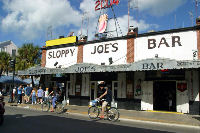 | |
Bankable Bar Bets
$ A Roman noble ordered Pope Gregory VII to be kidnapped, beaten up, and imprisoned. The Romans clamored for the pope’s release and got it.
$ Eupraxia, the second wife of Emperor Henry IV, publicly accused her husband of holding her prisoner, forcing her to participate in orgies, and saying a black mass over her naked body.
$ Pope Gregory VII forced Emperor Henry IV, who was submissively pleading for papal forgiveness, to stand outside in freezing cold weather with neither hat nor shoes for three days.
$ The loyally Christian Normans allied themselves with the pope against the emperor. Nevertheless, they seized Rome and sacked it.
$ For twenty years an antipope, Clement III, claimed the papacy with the support of the emperor. He appointed his own cardinals and was supported by several whom he did not appoint. For years on end he was considered the legitimate pope by most Romans.
$ Pope Urban II spent over five years as a beggar wandering around southern Italy.
